| Approach: Team |
Level:
Year 8 |
|
| Focus:
Stereotypes |
| Resources: 8 picture cards with statements, “Agree/Disagree” chart, 4 prompt cards, recording sheet, “Working Together” card |
|
|
Questions/instructions:
Show and explain Working Together card.
Place pile of cards, upside down, on table.
For this activity, we have eight cards. Each card says something that you may or may not agree with. Let’s see which you agree with and which you do not agree with. We’ll look at one card at a time.
The first person (Student 1) will take a card from the top of the pile, and then read what is on it to the others. They’ll also show the others the picture.
Each of the other people, in turn, will say if they agree or do not agree with the statement and give their reasons.
|
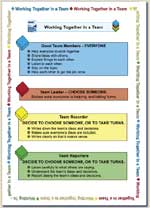
[Click on card to enlarge.]
|
After everyone has done this, the person who read out the statement will decide whether to agree or disagree with the statement. They’ll put the card on this chart, to show what they have decided.
Place Agree/Don’t Agree chart in front of team.
When the person has put the card on the chart, he or she explains their reasons to the others.
The next person in the team then picks up another card, and the process is repeated until all the cards have been discussed and placed on the chart.
Here is a prompt card to remind you what to do.
Hand out prompt cards to each student.
Let’s start with (Student 1’s name). |
|
|
%
responses
2006 ('02) |
| y8
|
| Card 1: It’s OK for men to cry |
|

|
Final decision: |
agree |
94 (98) |
disagree |
5 (2) |
neither agree nor disagree |
1 (0) |
How well was the case
for that decision made?
|
extremely/very well |
3 (2) |
well |
13 (28) |
moderately well |
58 (56) |
poorly |
26 (14) |
| Card 2: Thin people are fitter than
fat people. |
|
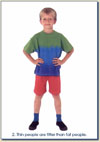
|
Final decision: |
agree |
26 (30) |
disagree |
71 (68) |
neither agree nor disagree |
3 (2) |
How well was the case
for that decision made?
|
extremely/very well |
9 (4) |
well |
18 (14) |
moderately well |
38 (57) |
poorly |
35 (25) |
| Card 3: Girls can be as good as
boys at playing rugby. |
|
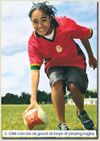
|
Final decision: |
agree |
87 (79) |
disagree |
11 (19) |
neither agree nor disagree |
2 (2) |
How well was the case
for that decision made?
|
extremely/very well |
3 (3) |
well |
21 (23) |
moderately well |
49 (51) |
poorly |
27 (23) |
| Card 4: Women rather than men should
do the cooking and housework. |
|
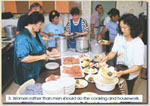
|
Final decision: |
agree |
16 (9) |
disagree |
82 (89) |
neither agree nor disagree |
2 (2) |
How well was the case
for that decision made?
|
extremely/very well |
4 (2) |
well |
23 (25) |
moderately well |
50 (53) |
poorly |
23 (20) |
| Card 5: Old people don’t understand
how young people feel. |
|

|
Final decision: |
agree |
28 (32) |
disagree |
70 (63) |
neither agree nor disagree |
2 (5) |
How well was the case
for that decision made?
|
extremely/very well |
4 (0) |
well |
17 (16) |
moderately well |
55 (67) |
poorly |
24 (17) |
| Card 6: Children in wheelchairs should have their own schools. |
|
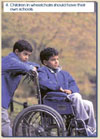
|
Final decision: |
agree |
24 (21) |
disagree |
74 (79) |
neither agree nor disagree |
2 (0) |
How well was the case
for that decision made?
|
extremely/very well |
11 (10) |
well |
28 (29) |
moderately well |
52 (54) |
poorly |
9 (7) |
| Card 7: Only women should wear
earrings. |
|
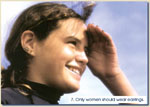
|
Final decision: |
agree |
8 (12) |
disagree |
92 (88) |
neither agree nor disagree |
0 (0) |
How well was the case
for that decision made?
|
extremely/very well |
4 (4) |
well |
23 (10) |
moderately well |
47 (63) |
poorly |
26 (23) |
| Card 8: All New Zealanders should learn to speak Mäori |
|
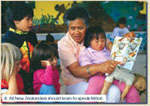
|
Final decision: |
agree |
24 (18) |
disagree |
71 (79) |
neither agree nor disagree |
5 (3) |
How well was the case
for that decision made?
|
extremely/very well |
6 (4) |
well |
29 (28) |
moderately well |
52 (51) |
poorly |
13 (17) |
|
Total
score: |
15–24
|
11 (7) |
12–14 |
16 (16) |
9–11 |
19 (25) |
6–8 |
28 (38) |
0–5 |
26 (14) |








